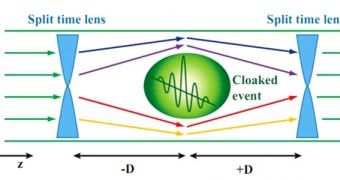A collaboration of physicists at the Cornell University, in Ithaca, New York, announces the creation of a hole in time, an artificial construct that enables users to conceal the very existence of a light pulse for about 110 nanoseconds. This is one of the most remarkable scientific discoveries made in 2011.
The research team was led by Cornell investigator Moti Fridman. He explains that what the group constructed is, in essence, a cloak capable of hiding events in time. This remarkable achievement was made possible by recent progress in learning how to distort electromagnetic fields in extreme ways.
Experts used the latest innovations in science to create the temporal equivalent of an optical invisibility cloak. This was made possible by the fact that space and time have a tendency to share what could best be described as a “duality” in electromagnetic theories.
Particularly, the Cornell team used the fact that light diffraction and dispersion exhibit a spacetime symmetry. This means that the diffraction exhibited by a beam of photons as it's moving is the precise mathematical equivalent of the time it takes the same beam to propagate though a dispersive medium.
Finding this equivalence led researchers to wonder whether it's possible to construct a lens capable of focusing light in time by using dispersion. The equivalent – using a lens capable of focusing light in space using diffraction– is entirely possible, so why not the other way around?
In order to produce this construct, the team used an electro-optic modulator, which they shaped into something they called a time-lens. “This time-lens can, for example, magnify or compress in time,” the Cornell team leader explains.
In the actual “time machine,” light passes through a series of two time-lenses. The first one compresses light, whereas the second one expands it back again. However, while the light is trapped in the gap between the two lenses, there is no way of telling whether the beam was ever emitted or not.
To an observer located outside the second time-lens, the light coming out of the device looks unaltered, as if nothing had happened to it just fractions of a second before. The gap in which it was trapped therefore acted like a cloak, concealing and eliminating all traces of any changes.
Details of how the new system works were published in a paper called “Demonstration Of Temporal Cloaking,” which is published in the online scientific journal arXiv. The team reports that the maximum time suppression they can achieve with the device is 120 microseconds, Technology Review reports.

 14 DAY TRIAL //
14 DAY TRIAL //